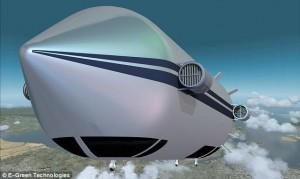Sky Power at 230 Feet!
Here’s a big way to traverse the sky!

More than 70 years after the Hindenburg disaster ended the golden airship era, giant blimps will take to the skies again with the launch of the world’s largest inflatable craft.
The pioneering Bullet 580 is a 235ftlong and 65ft in diameter ship that can lift payloads of 2,000lbs up to 20,000ft in the air.
Source: World’s largest airship lifts off for the first time
Read more: http://www.dailymail.co.uk/sciencetech/article-1279831/Up-away-Worlds-largest-airship-lifts-time.html#ixzz0vVq0aB2c
It was inflated this week inside the Garret Coliseum in Alabama – one of the few facilities large enough to host the ship. The process took the developers at E-Green Technologies just over six hours.
The £5.5million craft can be flown remotely or with a crew. The company plan to build a fleet of hire vehicles that they will rent out for between £200,000 and £550,000 a month.
Chief Executive of E-Green Technologies, Mike Lawson, said: ‘It’s slow enough to be used for sightseeing, large enough to carry heavy cargo and enough volume of lifting capability to be flied 20,000ft unmanned. So you have a gift of all different technologies.’
Lift is provided by a system of seven bags filled with helium, while the inner hull is full of ambient air. Hydrogen was used in the 1920s and 1930s because helium was considered too expensive at the time.
The payloads are carried inside the outer envelope of the balloon, which is only one sixteenth of an inch thick yet 10 times stronger than steel. It is made from a type of Kevlar, which is the tough material used to make bulletproof vests.
Mr Lawson, said:’If you hit a hard landing, the airship is just going to kind of bounce.’
Although the airship only has a top speed of 80MPH it can take-off and land vertically. The craft is also able to hover over an area for up to a week at a time – something neither airplanes or satellites cannot manage.
The craft could therefore keep a close watch on oil spills like the one in the Gulf of Mexico or monitor pirates off the coast of Somalia.
It could also serve as a near space satellite for broadcast communications, missile defense warnings, weather monitoring and geophysical surveys.
In fact its first mission planned for later this year, will be a joint project of Nasa and Old Dominion University, which will measure moisture content in soil.
Mr Lawson said he was confident that airships had a future in the 21st century, despite their bad press in the past.
His business acquired ’21st Century Airships’ in November 2009, which was the world’s leading airship research and development company.
The merged firm has already built and flown 14 prototypes, but the Bullet is their first commercial craft.
‘Airships have undergone surprisingly little evolution throughout their more than 150-year history, and this is what makes our E-Green proprietary designs so desirable to government and commercial customers,’ he said.
‘Our airships are radically different designs that move beyond the performance limitations of traditional blimps or zepplins by combing advanced technology with simple construction and the ability to fuel with algae, protecting our environment.’
Algae is the latest biofuel exciting scientists. It draws carbon dioxide from the atmosphere when it grows and when the derived fuel is burned this same CO2 is released, making the fuel theoretically zero-carbon. Algae farms can also be created using brackish and waste water.
The Bullet also has a Water Condensate Recovery System, which reduces the need for helium replenishment.
The Bullet’s first test flights are planned for this summer and the ship will be piloted by Captain Allan Judd who has been at the helm of smaller airships since 1986.

Leave a Reply
Want to join the discussion?Feel free to contribute!